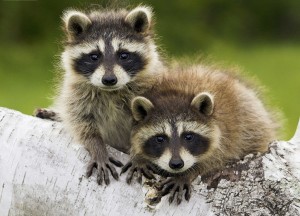Raccoon (Procyon lotor)
Raccoon (Procyon lotor)
Photo Credit: http://www.raccoonfactshub.com
Raccoons are highly intelligent & inquisitive. They are easily identified by the black mask around their eyes and by the vertical black stripe between their eyes. They have a ringed tail and pointed muzzle. They are excellent swimmers and good climbers. Molecular studies indicate raccoons are related to the bear. Raccoons are most abundant in the eastern part of Kansas where there are more mature deciduous and mixed forests, waterways and agriculture. Since amphibians, crustaceans and other animals found around the shore of lakes, rivers and marshes are an important part of the raccoon’s diet, lowland deciduous and mixed forests sustain the highest population densities of raccoon. The exceptional tactile sensation on their front paws helps them detect food in streams. Being omnivorous, they also eat corn, milo, acorns, mulberries, fruits, nuts, berries plus grasshoppers, fish, frogs, clams, crayfish and eggs. Although they do not hibernate, they will den to avoid cold weather or deep snowfall. Dens are hollow trees, rock crevices & burrows of other animals including abandoned beaver lodges. Fossils found in the Great Plains date back to the Pliocene era. Today raccoons are expanding their range north into Canada as temperatures continue to rise. Oh yes, since they are nocturnal, if they get into your attic they will keep you up all night. Since raccoons have the potential for carrying rabies, programs exist for trapping, vaccinating and releasing animals to reduce the spread of the disease.

